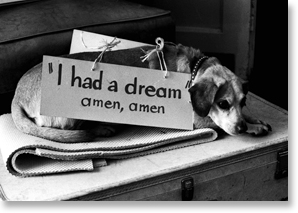|
Dreams, Themes and Schemes The Struggle Over The True Legacy Of Martin King Part 2 by Boyd Lewis Los Angeles, California The dedication of the Martin Luther King memorial monument discussed in this essay was postponed by Hurricane Irene. The Memorial Committee is expected to reschedule the dedication to take place in September or October, 2011.
Dr. King’s last great work was to be a nonviolent revolution, a peaceful confrontation to demand that policy makers and power brokers pay attention to the wholesale human suffering going on from Appalachia to Watts." Then Memphis intervened. The conditions faced by striking sanitation workers in The Bluff City were so vile, so death-bringing, exploitive to the extent of resembling a slave past, that Dr. King took a detour. Memphis was waging economic warfare on its poorest citizens. He had no choice but to go to Memphis. This intervention cost him his life. His concern about economic injustice killed him, not the search for racial peace we see chiseled and embodied and made monumentally official in the D.C. Memorial. After Dr. King witnessed the sprawling slums of Chicago and conditions creating them in 1966, he said at a recorded SCLC staff meeting in Atlanta: “Maybe America must move toward a democratic socialism.” This was where the man’s real dream was going in his final years on earth. Not all who worked with him at SCLC would disagree. In 1967, Dr. King told the SCLC national convention that the Movement must shift gears to address the restructuring the whole of American society and its economic system in order to bring a broader and more fair distribution of wealth. Capitalism itself, he told the rights fighters, had to come under critical questioning. “Capitalism has often left a gulf between superfluous wealth and abject poverty, encouraging a cutthroat competition and selfish ambition.” In January 1968, he decried the injustice of a system where “Hundreds of thousands of Negroes are working full time jobs at part-time wages.” In February 1968 he called for a policy for the redistribution of economic power. “The roots of economic injustice,” he said, “are in the system (capitalism) itself.” I will be very surprised if any of this made it past the program committee of the King Memorial. During 1967, the U.S. went through 75 major riots resulting in 83 deaths. The Kerner Commission appointed by Congress found, not surprisingly, that hopelessness brought about by poverty, aimless youth without a chance for a job, and police misconduct were the dominant cause of the longest of the Long Hot Summers. These were not thugs or vandalizing criminals. There was a clear stimulus and riots were the response of the hopeless class. Desperate times call for desperate measures, we’re told. The late ’60s urban unrest and militancy then overtaking young people had forced Dr. King to readjust his definition of nonviolence, long a central value of the Movement. Under King’s new concept, the tactic was to morph into a more muscular method of fighting, nonviolently of course. Today nonviolence is equated with passive resistance, folding yourself into a ball to avoids the boots and bats of the racist mob. Not fighting back. Turn the other cheek to be bloodied in its turn. But in his last year, Dr. King said: “The nonviolent approach can exist only in the context of justice…to remain nonviolent in the face of submission to injustice is a suicidal course.” Dr. King called for a new direction: aggressive nonviolence to combat injustice and what came to be called “massive resistance.” Dr. King said the tactic must now develop a “disruptive dimension” if it was to be effective; blocking the doorways of state and federal buildings as nonviolence, stopping the car, turning off the engine, locking it in the nation’s busiest streets then walking away as nonviolence. This was new. And there was nothing dreamy about it. Otherwise, he told audiences, the cries of the poor would not be heeded. Then the fire really would come next time, as the Bible and James Baldwin had predicted. Martin King is often depicted as an American emblem complete with flags and eagles. But he was no blind patriot. His opposition to expensive, murderous wars of choice overseas broke out into the open April 4, 1967, exactly one year before his murder with a speech to Riverside Church in New York. He was the first major civil rights leader to oppose the Vietnam War, earning him the condemnation of the NAACP, Urban League, National Baptist Convention and many unions of the AFL-CIO. Linking an end to the war to civil rights progress was controversial even within SCLC. Quotes not likely to be recalled the last Sunday in August:
In some future time, all of this will be forgotten as generations of children flock to the King Memorial on the Reflecting Pool in Washington, cross their arms across an imagined suit and look sternly into the middle distance and take turns chortling to one another “I Have a Dream.”
|
||||||
If you have any thoughts on this or would like to contribute to an ongoing discussion in the  What is New? || Affirmative Action || Art Changes || Autonomy: Chiapas - California || Community Images || Education Rights || E-mail, Opinions and Discussion || En español || Essays from Ireland || Global Eyes || Healthcare || Human Rights/Civil Rights || Piri Thomas || Photo of the Week || QA: Interviews || Region || Rural America || Search || Donate || To be notified of new articles || Survey || In Motion Magazine's Store || In Motion Magazine Staff || In Unity Book of Photos || Links Around The World NPC Productions Copyright © 1995-2020 NPC Productions as a compilation. All Rights Reserved. |



